Transcriptome Analysis of the CML Gene Family in Bletilla striata and Regulation of Militarine Synthesis Under Sodium Acetate and Salicylic Acid Treatments
Abstract
1. Introduction
2. Results
2.1. Functional Annotation of BsCML
2.2. Identification and Proteins Physicochemical Property Analysis of BsCML
2.3. Amino Acid Conserved Motifs and Gene Structure Analysis
2.4. Phylogenetic Analysis of the BsCML Family
2.5. Detection of EST-SSR
2.6. Cis-Acting Elements of the BsCML Gene
2.7. Interactions Among BsCML Proteins
2.8. Expression Patterns of BsCML Under NaAc and SA Treatment and Their Effects on Growth and Secondary Metabolite Accumulation in B. striat
2.9. Analysis of BsCML Regulation on Militarine and Dactylorhin A Synthesis Under Elicitor Treatment
2.10. Analysis of BsCML Expression and Militarine Accumulation in Different B. striata Tissues
3. Discussion
3.1. Evolutionary Analysis of the BsCML Family
3.2. Expression Pattern and Functional Analysis of the BsCML Gene Family
3.3. Prospective Applications of Inducer-Mediated CML Expression in Regulating Secondary Metabolite Biosynthesis
4. Materials and Methods
4.1. Experimental Materials
4.2. Detection of Secondary Metabolite Accumulation in Callus by HPLC
4.3. Characteristic Analysis Based on Nucleotide and Amino Acid Sequences
4.3.1. Identification of BsCML Family Members in B. striata
4.3.2. Analysis of Conserved Motifs and Domains of BsCML
4.3.3. Analysis of Physical and Chemical Properties of Proteins
4.3.4. Detection and Validation of EST-SSR
4.4. Functional Prediction Based on BsCML Sequence Features
4.4.1. Subcellular Localization, Signal Peptide Identification, Transmembrane Structure, and Cis-Element Analysis of the BsCML Gene
4.4.2. Analysis of Evolutionary Characteristics of the BsCML Gene Family
4.4.3. Interaction Network Analysis of BsCML Family Proteins
4.5. Functional Verification and Analysis of the BsCML Gene Family
4.5.1. Expression Pattern Analysis and Quantitative Fluorescence PCR Validation of BsCML
4.5.2. Expression Profile Analysis of BsCML in Different B. striata Tissues
4.5.3. LC-MS Detection of Secondary Metabolite Accumulation in Different B. striata Tissues
5. Conclusions
Author Contributions
Funding
Data Availability Statement
Conflicts of Interest
References
- Ranty, B.; Aldon, D.; Cotelle, V.; Galaud, J.P.; Thuleau, P.; Mazars, C. Calcium sensors as key hubs in plant responses to biotic and abiotic stresses. Front. Plant Sci. 2016, 7, 327. [Google Scholar] [CrossRef]
- Jiang, Y.; Ding, P. Calcium signaling in plant immunity: A spatiotemporally controlled symphony. Trends Plant Sci. 2023, 28, 74–89. [Google Scholar] [CrossRef]
- Wang, C.; Luan, S. Calcium homeostasis and signaling in plant immunity. Curr. Opin. Plant Biol. 2024, 77, 102485. [Google Scholar] [CrossRef]
- Zheng, Z.; Shen, J.; Pan, W.; Pan, J. Calcium sensors and their stress signaling pathways in plants. Hereditas 2013, 35, 875–884. [Google Scholar] [CrossRef]
- Kudla, J.; Batistič, O.; Hashimoto, K. Calcium signals: The lead currency of plant information processing. Plant Cell 2010, 22, 541–563. [Google Scholar] [CrossRef]
- Luan, S.; Kudla, J.; Rodriguez-Concepcion, M.; Yalovsky, S.; Gruissem, W. Calmodulins and calcineurin B-like proteins: Calcium sensors for specific signal response coupling in plants. Plant Cell 2002, 14, S389–S400. [Google Scholar] [CrossRef]
- Wang, L.; Liu, Z.; Han, S.; Liu, P.; Sadeghnezhad, E.; Liu, M. Growth or survival: What is the role of calmodulin-like proteins in plant? Int. J. Biol. Macromol. 2023, 242, 124733. [Google Scholar] [CrossRef] [PubMed]
- Mohanta, T.K.; Yadav, D.; Khan, A.L.; Hashem, A.; Abd Allah, E.F.; Al-Harrasi, A. Molecular players of EF-hand containing calcium signaling event in plants. Int. J. Mol. Sci. 2019, 20, 1476. [Google Scholar] [CrossRef] [PubMed]
- Young, B.D.; Cook, M.E.; Costabile, B.K.; Samanta, R.; Zhuang, X.; Sevdalis, S.E.; Varney, K.M.; Mancia, F.; Matysiak, S.; Lattman, E.; et al. Binding and functional folding (BFF): A physiological framework for studying bio-molecular interactions and allostery. J. Mol. Biol. 2022, 434, 167872. [Google Scholar] [CrossRef]
- Delk, N.A.; Johnson, K.A.; Chowdhury, N.I.; Braam, J. CML24, regulated in expression by diverse stimuli, encodes a potential Ca2+ sensor that functions in responses to abscisic acid, daylength, and ion stress. Plant Physiol. 2005, 139, 240–253. [Google Scholar] [CrossRef]
- Köster, P.; DeFalco, T.A.; Zipfel, C. Ca signals in plant immunity. EMBO J. 2022, 41, e110741. [Google Scholar] [CrossRef]
- Song, X.; Li, J.; Lyu, M.; Kong, X.; Hu, S.; Song, Q.; Zuo, K. CALMODULIN-LIKE-38 and PEP1 RECEPTOR 2 integrate nitrate and brassinosteroid signals to regulate root growth. Plant Physiol. 2021, 187, 1779–1794. [Google Scholar] [CrossRef] [PubMed]
- Lokdarshi, A.; Conner, W.C.; McClintock, C.; Li, T.; Roberts, D.M. Arabidopsis CML38, a calcium sensor that localizes to ribonucleoprotein complexes under hypoxia stress. Plant Physiol. 2016, 170, 1046–1059. [Google Scholar] [CrossRef]
- Leba, L.J.; Cheval, C.; Ortiz-Martín, I.; Ranty, B.; Beuzón, C.R.; Galaud, J.P.; Aldon, D. CML9, an Arabidopsis calmodulin-like protein, contributes to plant innate immunity through a flagellin-dependent signalling pathway. Plant J. 2012, 71, 976–989. [Google Scholar] [CrossRef] [PubMed]
- Yu, S.; Wu, J.; Sun, Y.; Zhu, H.; Sun, Q.; Zhao, P.; Huang, R.; Guo, Z. A calmodulin-like protein (CML10) interacts with cytosolic enzymes GSTU8 and FBA6 to regulate cold tolerance. Plant Physiol. 2022, 190, 1321–1333. [Google Scholar] [CrossRef]
- Li, C.; Meng, D.; Zhang, J.; Cheng, L. Genome-wide identification and expression analysis of calmodulin and calmodulin-like genes in apple (Malus × domestica). Plant Physiol. Biochem. 2019, 139, 600–612. [Google Scholar] [CrossRef] [PubMed]
- Tang, M.; Xu, C.; Cao, H.; Shi, Y.; Chen, J.; Chai, Y.; Li, Z. Tomato calmodulin-like protein SlCML37 is a calcium (Ca2+) sensor that interacts with proteasome maturation factor SlUMP1 and plays a role in tomato fruit chilling stress tolerance. J. Plant Physiol. 2021, 258–259, 153373. [Google Scholar] [CrossRef]
- Yang, D.; Chen, T.; Wu, Y.; Tang, H.; Yu, J.; Dai, X.; Zheng, Y.; Wan, X.; Yang, Y.; Tan, X. Genome-wide analysis of the peanut CaM/CML gene family reveals that the AhCML69 gene is associated with resistance to Ralstonia solanacearum. BMC Genom. 2024, 25, 200. [Google Scholar] [CrossRef]
- Cho, K.M.; Nguyen, H.T.; Kim, S.Y.; Shin, J.S.; Cho, D.H.; Hong, S.B.; Shin, J.S.; Ok, S.H. CML10, a variant of calmodulin, modulates ascorbic acid synthesis. New Phytol. 2016, 209, 664–678. [Google Scholar] [CrossRef]
- Yi, F.; Li, Y.; Song, A.; Shi, X.; Hu, S.; Wu, S.; Shao, L.; Chu, Z.; Xu, K.; Li, L.; et al. Positive roles of the Ca2+ sensors GbCML45 and GbCML50 in improving cotton Verticillium wilt resistance. Mol. Plant Pathol. 2024, 25, e13483. [Google Scholar] [CrossRef]
- Li, Q.; Xu, M.; Wu, F.; Guo, Z.; Yang, N.; Li, L.; Wen, W.; Xu, D. Integrated transcriptomics and metabolomics provide insights into the biosynthesis of militarine in the cell suspension culture system of Bletilla striata. Adv. Biotechnol. 2024, 2, 25. [Google Scholar] [CrossRef]
- Jia, X.; Li, Q.; Xu, M.; Zhang, J.; Xu, D. Advances in militarine: Pharmacology, synthesis, molecular regulation and regulatory mechanisms. Heliyon 2024, 10, e24341. [Google Scholar] [CrossRef] [PubMed]
- Commission, C.P. Pharmacopoeia of the People’s Republic of China, 2020th ed.; China Medical Science Press: Beijing, China, 2020. [Google Scholar]
- Boonburapong, B.; Buaboocha, T. Genome-wide identification and analyses of the rice calmodulin and related potential calcium sensor proteins. BMC Plant Biol. 2007, 7, 4. [Google Scholar] [CrossRef][Green Version]
- Qian, Z.; Gu, S.; Zhao, X.; Rao, X.; Zeng, D.; Shen, Q.; Zhang, R.; Chen, S.; He, L.; Li, F. Identification and cold stress expression analysis of CML gene family in Erianthus fulvus based on transcriptome. J. Agric. Biotechnol. 2022, 30, 885–895. [Google Scholar] [CrossRef]
- Yang, Q.; Wang, T.; Liang, L.; Li, L.; Liu, L. Genome-wide analysis of CaM/CML gene family in two Orchidaceae species. Forest Res. 2018, 31, 15–25. [Google Scholar] [CrossRef]
- Cai, K.; Kuang, L.; Yue, W.; Xie, S.; Xia, X.; Zhang, G.; Wang, J. Calmodulin and calmodulin-like gene family in barley: Identification, characterization and expression analyses. Front. Plant Sci. 2022, 13, 964888. [Google Scholar] [CrossRef]
- Liu, Y.; Yin, F.; Liao, L.; Shuai, L. Genome-wide identification and expression analysis of calmodulin-like proteins in cucumber. PeerJ 2023, 11, e14637. [Google Scholar] [CrossRef]
- Munir, S.; Khan, M.R.; Song, J.; Munir, S.; Zhang, Y.; Ye, Z.; Wang, T. Genome-wide identification, characterization and expression analysis of calmodulin-like (CML) proteins in tomato (Solanum lycopersicum). Plant Physiol. Biochem. 2016, 102, 167–179. [Google Scholar] [CrossRef]
- Li, Q.; Gao, L.; Yu, F.; Lü, S.; Yang, P. Evolution and diversification of CaM/CML gene family in green plants. Plant Physiol. Biochem. 2023, 202, 107922. [Google Scholar] [CrossRef]
- Mohanta, T.K.; Kumar, P.; Bae, H. Genomics and evolutionary aspect of calcium signaling event in calmodulin and calmodulin-like proteins in plants. BMC Plant Biol. 2017, 17, 38. [Google Scholar] [CrossRef]
- Zhang, M.; Luo, D.; Fang, H.; Zhao, W.; Zheng, Y. Effect of light quality on the growth and main chemical composition of Bletilla striata. J. Plant Physiol. 2022, 272, 153690. [Google Scholar] [CrossRef] [PubMed]
- Qiu, H.; Guo, J.; Cui, L.J.; Yan, P.D.; Yan, Y.P. Effects of rhizosphere soil physical, chemical factors and fungal community on yield and quality of Bletilla striata. Shaanxi Agric. Sci. 2022, 68, 64–70. [Google Scholar] [CrossRef]
- Xiao, C.; Xu, C.; Zhang, J.; Jiang, W.; Zhang, X.; Yang, C.; Xu, J.; Zhang, Y.; Zhou, T. Soil microbial communities affect the growth and secondary metabolite accumulation in Bletilla striata (Thunb.) Rchb. f. Front. Microbiol. 2022, 13, 916418. [Google Scholar] [CrossRef]
- Midhat, U.; Ting, M.K.Y.; Teresinski, H.J.; Snedden, W.A. The calmodulin-like protein, CML39, is involved in regulating seed development, germination, and fruit development in Arabidopsis. Plant Mol. Biol. 2018, 96, 375–392. [Google Scholar] [CrossRef] [PubMed]
- Zhu, Q.; Tan, Q.; Gao, Q.; Zheng, S.; Chen, W.; Galaud, J.P.; Li, X.; Zhu, X. Calmodulin-like protein CML15 interacts with PP2C46/65 to regulate papaya fruit ripening via integrating calcium, ABA and ethylene signals. Plant Biotechnol. J. 2024, 22, 1703–1723. [Google Scholar] [CrossRef] [PubMed]
- Sun, Q.; Huang, R.; Zhu, H.; Sun, Y.; Guo, Z. A novel Medicago truncatula calmodulin-like protein (MtCML42) regulates cold tolerance and flowering time. Plant J. 2021, 108, 1069–1082. [Google Scholar] [CrossRef]
- Zhang, D.; Du, L.; Lin, J.; Wang, L.; Zheng, P.; Deng, B.; Zhang, W.; Su, W.; Liu, Y.; Lu, Y.; et al. Genome-wide identification and expression analysis of calmodulin and calmodulin-like genes in passion fruit (Passiflora edulis) and their involvement in flower and fruit development. BMC Plant Biol. 2024, 24, 626. [Google Scholar] [CrossRef]
- Sun, Q.; Yu, S.; Guo, Z. Calmodulin-like (CML) gene family in Medicago truncatula: Genome-wide identification, characterization and expression analysis. Int. J. Mol. Sci. 2020, 21, 7142. [Google Scholar] [CrossRef]
- Aleynova, O.A.; Suprun, A.R.; Ananev, A.A.; Nityagovsky, N.N.; Ogneva, Z.V.; Dubrovina, A.S.; Kiselev, K.V. Effect of calmodulin-like gene (CML) overexpression on stilbene biosynthesis in cell cultures of Vitis amurensis Rupr. Plants 2022, 11, 171. [Google Scholar] [CrossRef]
- Yin, F.; Zhao, M.; Gong, L.; Nan, H.; Ma, W.; Lu, M.; An, H. Genome-wide identification of Rosa roxburghii CML family genes identifies an RrCML13-RrGGP2 interaction involved in calcium-mediated regulation of ascorbate biosynthesis. Plant Physiol. Biochem. 2024, 214, 108874. [Google Scholar] [CrossRef]
- Teresinski, H.J.; Hau, B.; Symonds, K.; Kilburn, R.; Munro, K.A.; Doner, N.M.; Mullen, R.; Li, V.H.; Snedden, W.A. Arabidopsis calmodulin-like proteins CML13 and CML14 interact with proteins that have IQ domains. Plant Cell Environ. 2023, 46, 2470–2491. [Google Scholar] [CrossRef] [PubMed]
- Symonds, K.; Teresinski, H.J.; Hau, B.; Dwivedi, V.; Belausov, E.; Bar-Sinai, S.; Tominaga, M.; Haraguchi, T.; Sadot, E.; Ito, K.; et al. Functional characterization of calmodulin-like proteins, CML13 and CML14, as novel light chains of Arabidopsis class VIII myosins. J. Exp. Bot. 2024, 75, 2313–2329. [Google Scholar] [CrossRef]
- Heyer, M.; Scholz, S.S.; Reichelt, M.; Kunert, G.; Oelmüller, R.; Mithöfer, A. The Ca2+ sensor proteins CML37 and CML42 antagonistically regulate plant stress responses by altering phytohormone signals. Plant Mol. Biol. 2022, 109, 611–625. [Google Scholar] [CrossRef]
- Erb, M.; Kliebenstein, D.J. Plant secondary metabolites as defenses, regulators, and primary metabolites: The blurred functional trichotomy. Plant Physiol. 2020, 184, 39–52. [Google Scholar] [CrossRef] [PubMed]
- Li, Z.; Xiong, K.; Wen, W.; Li, L.; Xu, D. Functional endophytes regulating plant secondary metabolism: Current status, prospects and applications. Int. J. Mol. Sci. 2023, 24, 1153. [Google Scholar] [CrossRef]
- Koprivova, A.; Kopriva, S. Plant secondary metabolites altering root microbiome composition and function. Curr. Opin. Plant Biol. 2022, 67, 102227. [Google Scholar] [CrossRef]
- Aleynova, O.A.; Kiselev, K.V.; Suprun, A.R.; Ananev, A.A.; Dubrovina, A.S. Involvement of the calmodulin-like protein gene VaCML92 in grapevine abiotic stress response and stilbene production. Int. J. Mol. Sci. 2023, 24, 15827. [Google Scholar] [CrossRef] [PubMed]
- You, W.; Zhang, J.; Ru, X.; Xu, F.; Wu, Z.; Jin, P.; Zheng, Y.; Cao, S. CmCML11 interacts with CmCAMTA5 to enhance γ-aminobutyric acid (GABA) accumulation by regulating GABA shunt in fresh-cut cantaloupe. Plant Physiol. Biochem. 2024, 206, 108217. [Google Scholar] [CrossRef]
- Vadassery, J.; Reichelt, M.; Hause, B.; Gershenzon, J.; Boland, W.; Mithöfer, A. CML42-mediated calcium signaling co-ordinates responses to Spodoptera herbivory and abiotic stresses in Arabidopsis. Plant Physiol. 2012, 159, 1159–1175. [Google Scholar] [CrossRef]
- Tiwari, S.; Lata, C.; Chauhan, P.S. Salicylic acid: Metabolism, regulation, and functions in crop abiotic stress tolerance. In Augmenting Crop Productivity in Stress Environment; Ansari, S.A., Ansari, M.I., Husen, A., Eds.; Springer Nature: Singapore, 2022; pp. 257–274. [Google Scholar]
- Liu, J.; Qiu, G.; Liu, C.; Li, H.; Chen, X.; Fu, Q.; Lin, Y.; Guo, B. Salicylic acid, a multifaceted hormone, combats abiotic stresses in plants. Life 2022, 12, 886. [Google Scholar] [CrossRef]
- Oraei, M.; Panahirad, S.; Zaare-Nahandi, F.; Gohari, G. Pre-véraison treatment of salicylic acid to enhance anthocyanin content of grape (Vitis vinifera L.) berries. J. Sci. Food Agric. 2019, 99, 5946–5952. [Google Scholar] [CrossRef]
- Yi, G.E.; Robin, A.H.; Yang, K.; Park, J.I.; Hwang, B.H.; Nou, I.S. Exogenous methyl jasmonate and salicylic acid induce subspecies-specific patterns of glucosinolate accumulation and gene expression in Brassica oleracea L. Molecules 2016, 21, 1417. [Google Scholar] [CrossRef] [PubMed]
- Miao, Y.; Li, H.; Pan, J.; Zhou, B.; He, T.; Wu, Y.; Zhou, D.; He, W.; Chen, L. Salicylic acid modulates secondary metabolism and enhanced colchicine accumulation in long yellow daylily (Hemerocallis citrina). AoB Plants 2024, 16, plae029. [Google Scholar] [CrossRef] [PubMed]
- Hadizadeh, M.; Ofoghi, H.; Kianirad, M.; Amidi, Z. Elicitation of pharmaceutical alkaloids biosynthesis by salicylic acid in marine microalgae Arthrospira platensis. Algal Res. 2019, 42, 101597. [Google Scholar] [CrossRef]
- Liu, H.; Huang, C.; Li, Q.; Wang, M.; Xiao, S.; Shi, J.; He, Y.; Wen, W.; Li, L.; Xu, D. Genome-wide identification of genes related to biosynthesis of phenolic acid derivatives in Bletilla striata at different suspension culture stages. Front. Plant Sci. 2022, 13, 875404. [Google Scholar] [CrossRef] [PubMed]
- Chen, C.; Wu, Y.; Li, J.; Wang, X.; Zeng, Z.; Xu, J.; Liu, Y.; Feng, J.; Chen, H.; He, Y.; et al. TBtools-II: A “one for all, all for one” bioinformatics platform for biological big-data mining. Mol. Plant 2023, 16, 1733–1742. [Google Scholar] [CrossRef]
- Duvaud, S.; Gabella, C.; Lisacek, F.; Stockinger, H.; Ioannidis, V.; Durinx, C. Expasy, the Swiss Bioinformatics Resource Portal, as designed by its users. Nucleic Acids Res. 2021, 49, W216–W227. [Google Scholar] [CrossRef]
- Saeed, F.; Hashmi, M.H.; Aksoy, E.; Demirel, U.; Bakhsh, A. Identification and characterization of RNA polymerase II (RNAP) C-terminal domain phosphatase-like 3 (SlCPL3) in tomato under biotic stress. Mol. Biol. Rep. 2023, 50, 6783–6793. [Google Scholar] [CrossRef]
- Horton, P.; Park, K.J.; Obayashi, T.; Fujita, N.; Harada, H.; Adams-Collier, C.J.; Nakai, K. WoLF PSORT: Protein localization predictor. Nucleic Acids Res. 2007, 35, W585–W587. [Google Scholar] [CrossRef]
- Szklarczyk, D.; Kirsch, R.; Koutrouli, M.; Nastou, K.; Mehryary, F.; Hachilif, R.; Gable, A.L.; Fang, T.; Doncheva, N.T.; Pyysalo, S.; et al. The STRING database in 2023: Protein-protein association networks and functional enrichment analyses for any sequenced genome of interest. Nucleic Acids Res. 2023, 51, D638–D646. [Google Scholar] [CrossRef]
- Robert, X.; Gouet, P. Deciphering key features in protein structures with the new ENDscript server. Nucleic Acids Res. 2014, 42, W320–W324. [Google Scholar] [CrossRef] [PubMed]

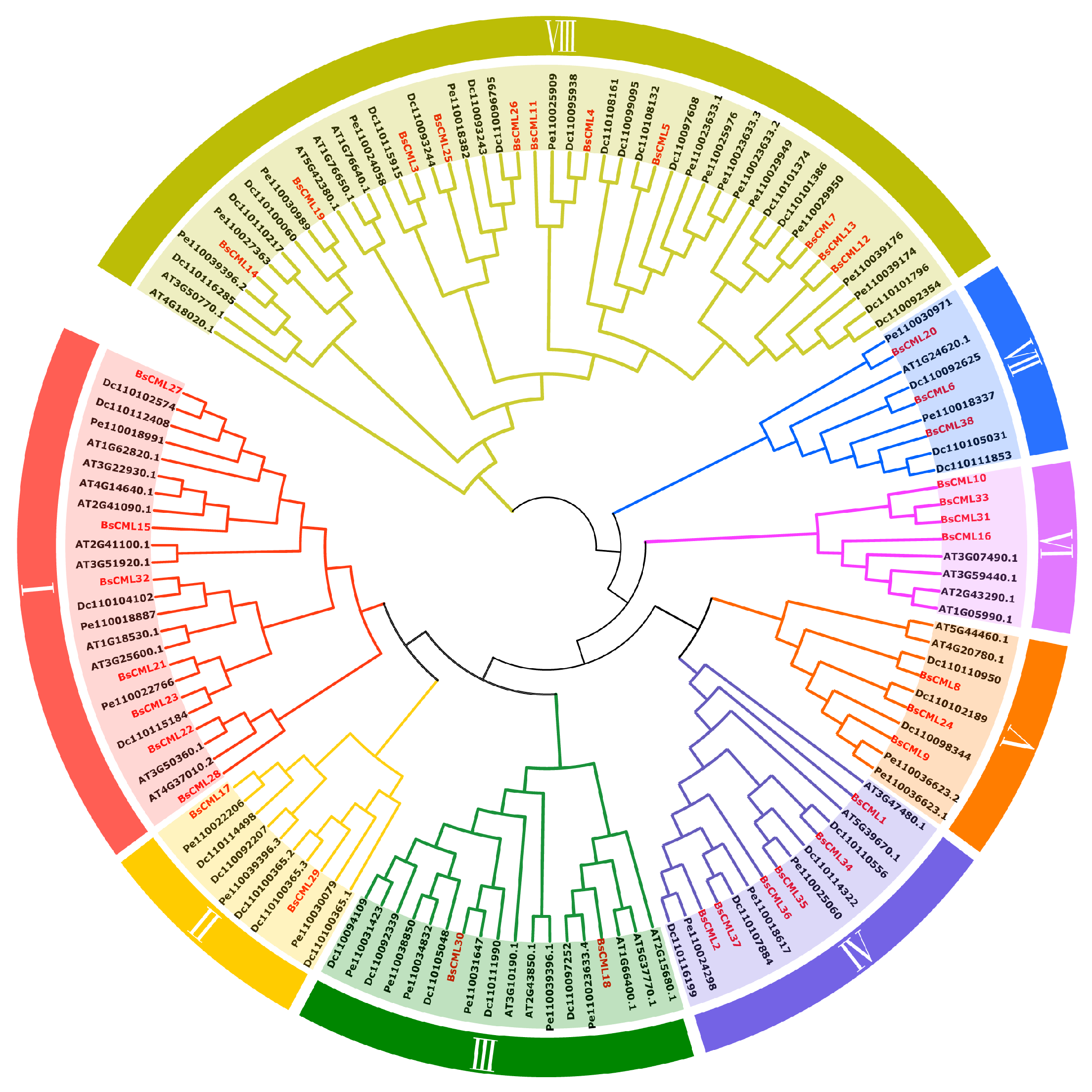
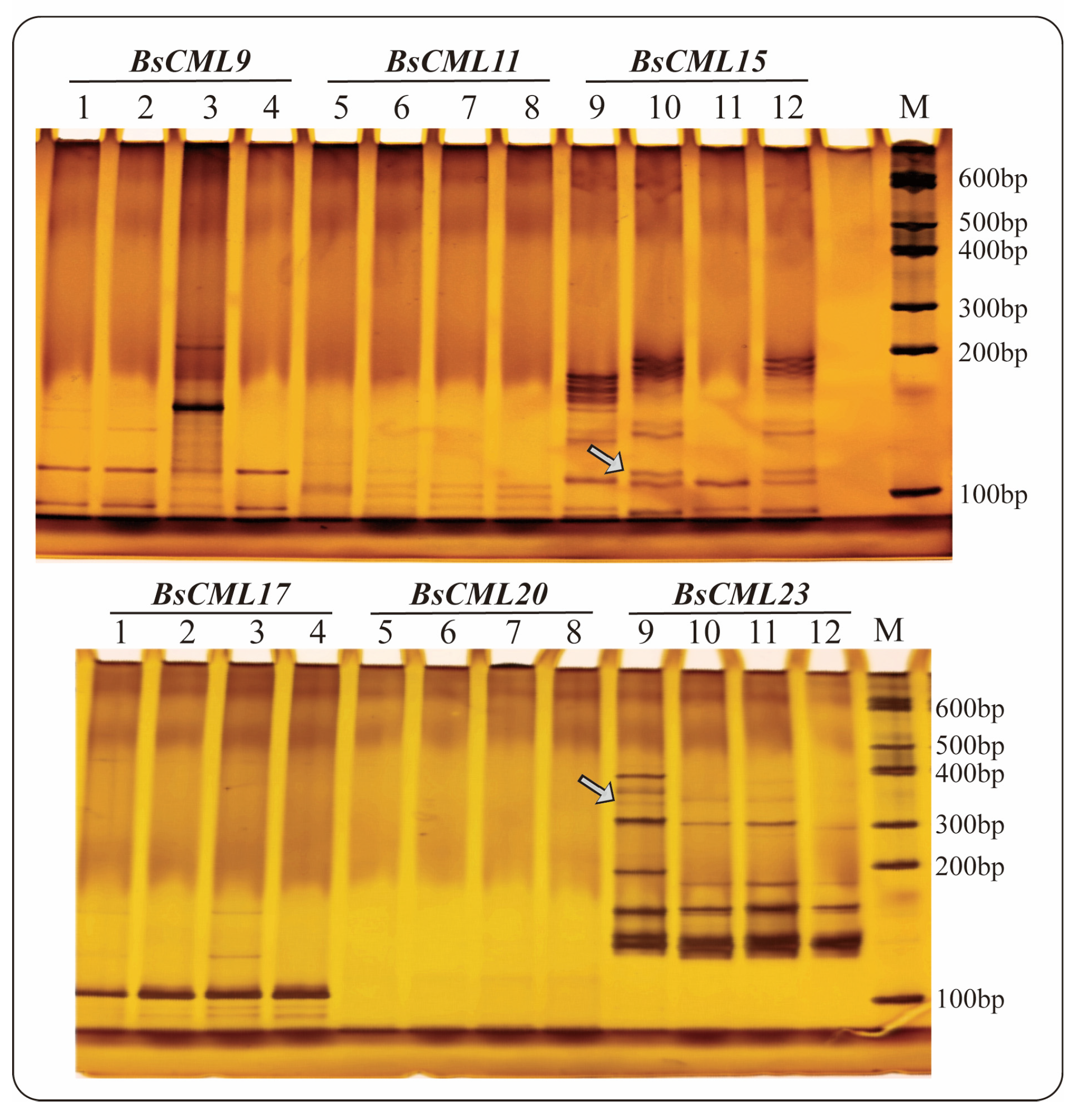
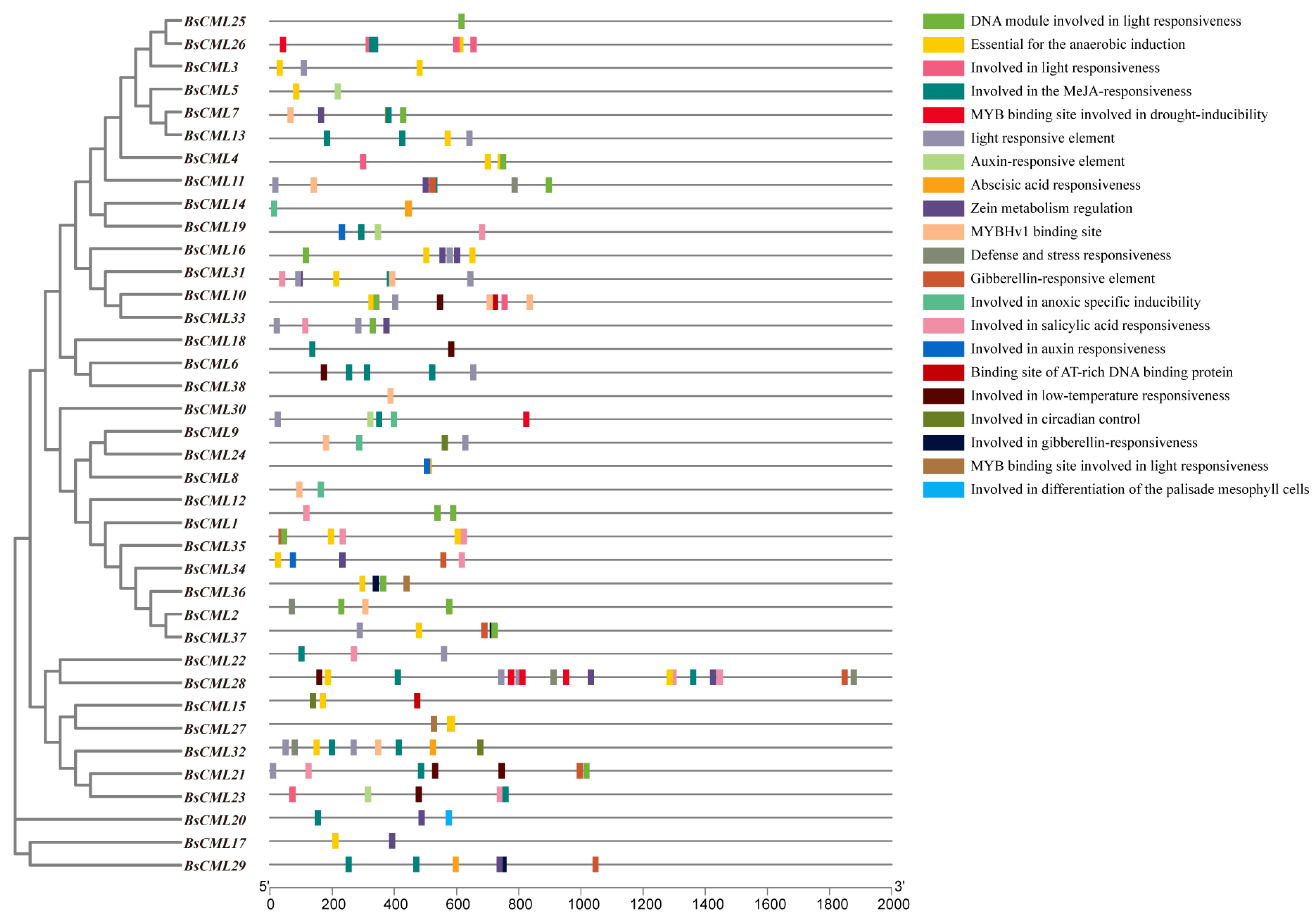

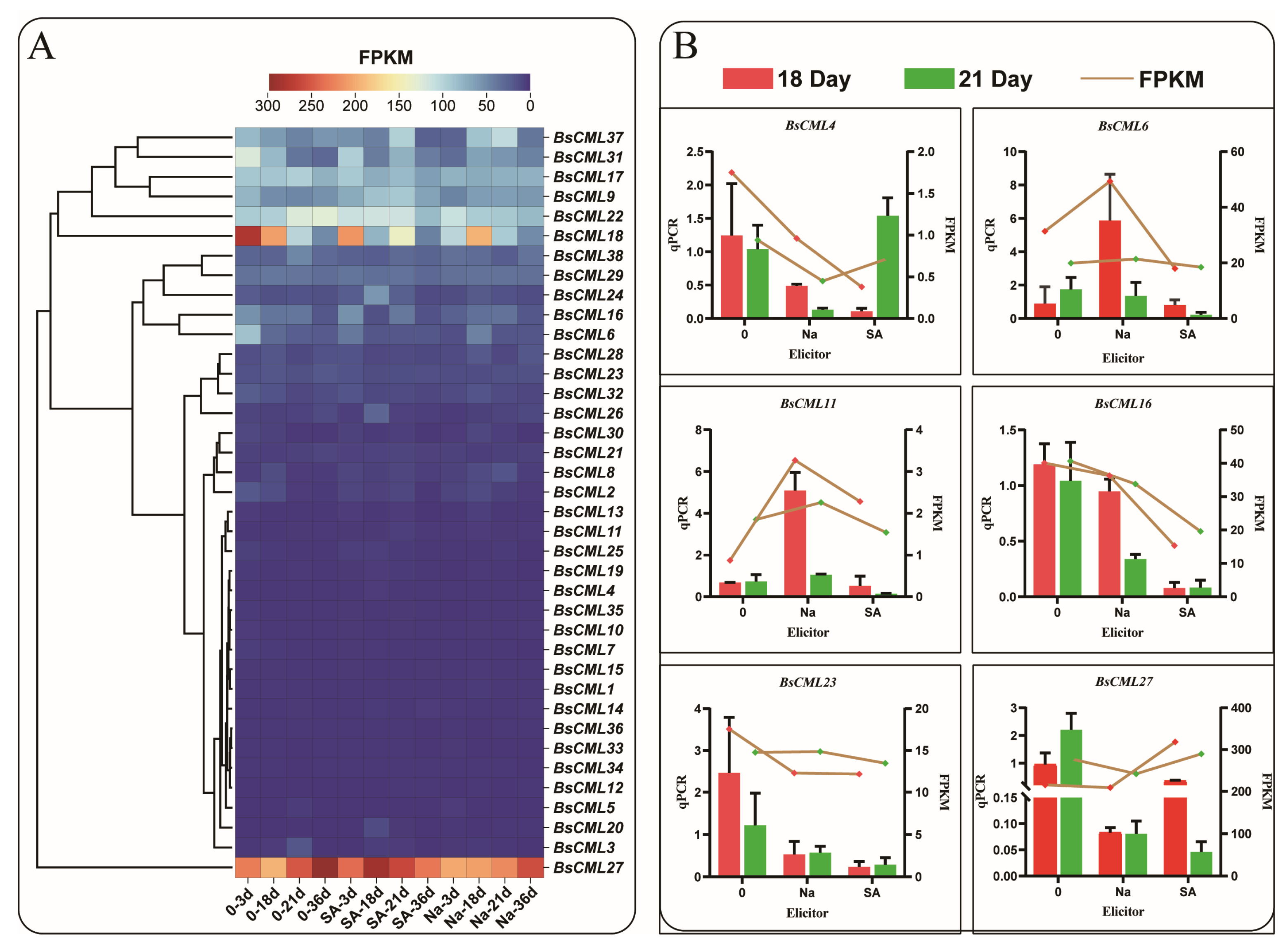


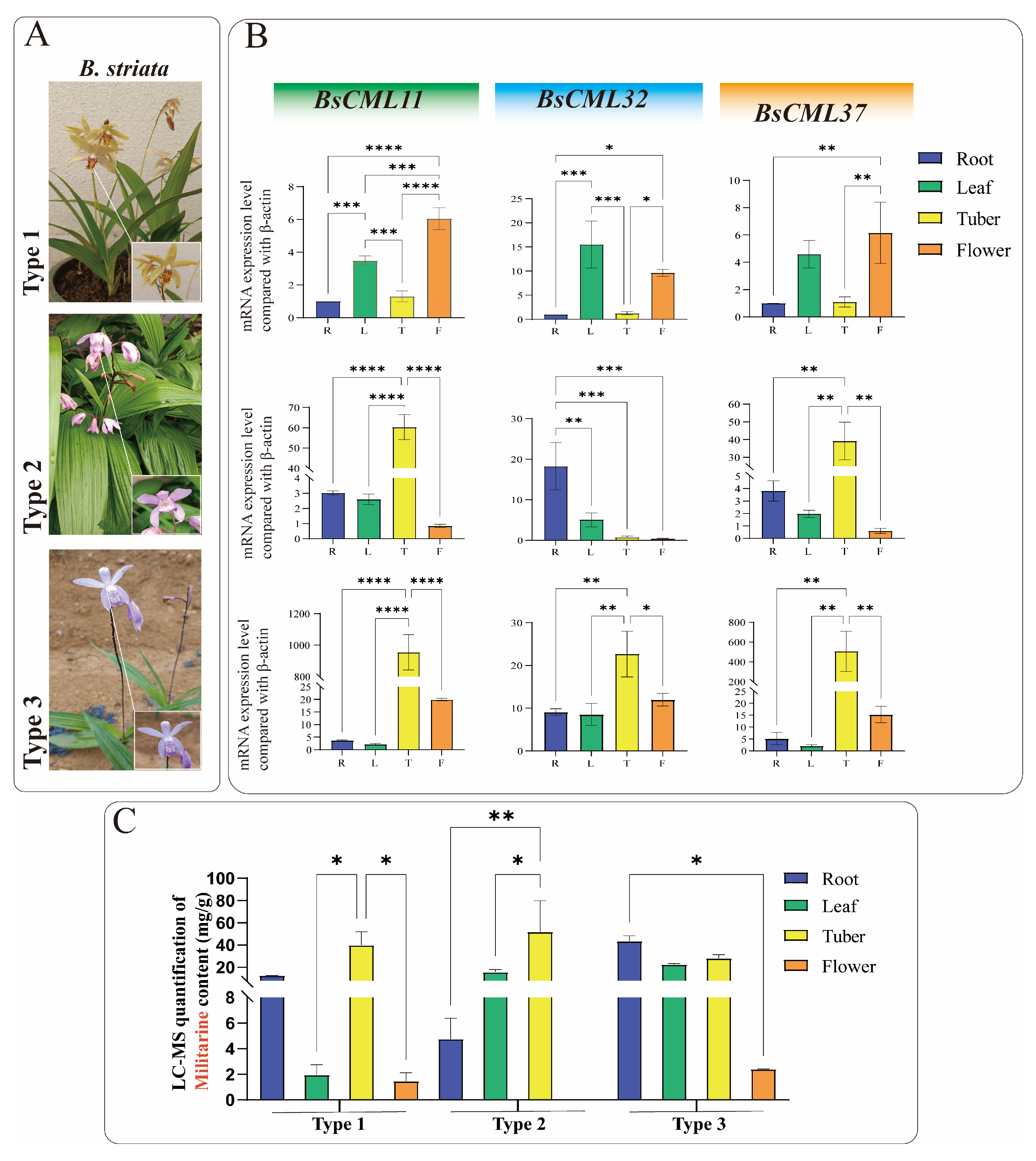
| Initial Sample ID | Gene Name | AA | MW/Da | pI | Instability Index | Aliphatic Index | GRAVY | Cell Localization |
|---|---|---|---|---|---|---|---|---|
| TRINITY_DN19138_c0_g1 | BsCML1 | 179 | 20,577.79 | 5.24 | 35.34 | 94.80 | −0.101 | Outside the cell |
| TRINITY_DN26172_c0_g1 | BsCML2 | 181 | 20,495.56 | 4.76 | 49.97 | 96.96 | −0.101 | Chloroplast |
| TRINITY_DN26571_c0_g1 | BsCML3 | 110 | 12,768.39 | 4.42 | 71.19 | 68.27 | −0.498 | Nucleus |
| TRINITY_DN28075_c0_g1 | BsCML4 | 200 | 22,455.40 | 4.79 | 44.41 | 77.10 | −0.468 | Chloroplast |
| TRINITY_DN2950_c0_g1 | BsCML5 | 104 | 12,116.79 | 4.25 | 47.11 | 80.67 | −0.348 | Nucleoplasm |
| TRINITY_DN3140_c0_g1 | BsCML6 | 190 | 20,739.08 | 4.50 | 41.73 | 70.37 | −0.459 | Nucleus |
| TRINITY_DN32186_c0_g1 | BsCML7 | 143 | 16,315.59 | 4.35 | 44.51 | 79.79 | −0.245 | Cytoplasm |
| TRINITY_DN32287_c0_g1 | BsCML8 | 71 | 7983.08 | 4.81 | 29.81 | 78.17 | −0.142 | Chloroplast |
| TRINITY_DN32287_c0_g2 | BsCML9 | 197 | 21,681.42 | 4.59 | 54.57 | 87.61 | −0.185 | Chloroplast |
| TRINITY_DN32415_c0_g1 | BsCML10 | 210 | 22,981.24 | 4.54 | 28.44 | 87.33 | −0.050 | Chloroplast |
| TRINITY_DN34106_c2_g1 | BsCML11 | 169 | 19,061.87 | 4.60 | 72.05 | 84.26 | −0.321 | Chloroplast |
| TRINITY_DN34539_c0_g1 | BsCML12 | 78 | 8942.06 | 4.36 | 55.61 | 87.56 | −0.404 | Chloroplast |
| TRINITY_DN34539_c0_g2 | BsCML13 | 144 | 16,522.78 | 4.56 | 57.28 | 80.56 | −0.351 | Cytoplasm |
| TRINITY_DN34644_c0_g1 | BsCML14 | 76 | 8570.50 | 4.29 | 60.26 | 53.95 | −0.659 | Nucleus |
| TRINITY_DN36231_c0_g3 | BsCML15 | 151 | 17,416.62 | 4.24 | 31.87 | 83.77 | −0.430 | Chloroplast |
| TRINITY_DN38066_c5_g3 | BsCML16 | 154 | 17,277.25 | 4.38 | 38.65 | 75.32 | −0.584 | Cytoplasm |
| TRINITY_DN40985_c3_g1 | BsCML17 | 271 | 29,322.21 | 6.31 | 56.17 | 65.65 | −0.368 | Nucleus |
| TRINITY_DN44252_c6_g1 | BsCML18 | 165 | 18,004.76 | 4.40 | 37.28 | 68.55 | −0.594 | Chloroplast |
| TRINITY_DN45768_c0_g1 | BsCML19 | 175 | 20,078.39 | 4.76 | 57.66 | 64.57 | −0.687 | Mitochondria |
| TRINITY_DN46042_c1_g1 | BsCML20 | 159 | 16,512.49 | 3.71 | 43.35 | 92.01 | 0.217 | Chloroplast |
| TRINITY_DN48433_c0_g3 | BsCML21 | 166 | 18,097.09 | 4.36 | 35.78 | 86.51 | −0.308 | Nuclear plastids |
| TRINITY_DN50047_c2_g2 | BsCML22 | 171 | 19,347.59 | 4.70 | 19.69 | 70.82 | −0.696 | Nucleus |
| TRINITY_DN50169_c2_g7 | BsCML23 | 157 | 17,540.53 | 4.42 | 32.96 | 89.55 | −0.362 | Nuclear plastids |
| TRINITY_DN50958_c2_g1 | BsCML24 | 188 | 20,703.16 | 4.66 | 49.73 | 80.43 | −0.354 | Mitochondria |
| TRINITY_DN51047_c0_g1 | BsCML25 | 176 | 19,973.81 | 5.00 | 52.25 | 80.91 | −0.368 | Chloroplast |
| TRINITY_DN51047_c0_g3 | BsCML26 | 176 | 19,751.21 | 4.62 | 58.48 | 70.91 | −0.470 | Nucleus |
| TRINITY_DN51580_c0_g3 | BsCML27 | 147 | 16,633.93 | 4.75 | 36.21 | 86.94 | −0.329 | Cytoplasm |
| TRINITY_DN51935_c2_g1 | BsCML28 | 121 | 13,850.40 | 4.10 | 44.61 | 75.04 | −0.440 | Cytoplasm |
| TRINITY_DN54559_c2_g2 | BsCML29 | 225 | 25,603.04 | 4.88 | 49.68 | 68.04 | −0.457 | Chloroplast |
| TRINITY_DN5534_c0_g1 | BsCML30 | 209 | 22,598.21 | 5.05 | 59.48 | 64.40 | −0.501 | Chloroplast |
| TRINITY_DN55906_c1_g2 | BsCML31 | 205 | 22,145.21 | 4.55 | 32.41 | 99.46 | 0.023 | Chloroplast |
| TRINITY_DN58835_c0_g2 | BsCML32 | 161 | 17,438.72 | 4.58 | 31.36 | 88.63 | −0.012 | Nucleus |
| TRINITY_DN5996_c0_g1 | BsCML33 | 189 | 21,237.32 | 4.48 | 31.80 | 94.92 | 0.014 | Chloroplast |
| TRINITY_DN60921_c0_g1 | BsCML34 | 177 | 20,115.05 | 4.34 | 26.27 | 88.64 | −0.006 | Nucleus |
| TRINITY_DN60932_c0_g1 | BsCML35 | 174 | 19,864.72 | 4.64 | 58.97 | 87.41 | −0.235 | Chloroplast |
| TRINITY_DN60945_c0_g1 | BsCML36 | 113 | 13,140.75 | 4.14 | 54.13 | 71.50 | −0.565 | Cytoplasm |
| TRINITY_DN7103_c0_g1 | BsCML37 | 178 | 20,429.54 | 4.74 | 38.91 | 77.19 | −0.193 | Chloroplast |
| TRINITY_DN7893_c0_g1 | BsCML38 | 185 | 19,965.29 | 4.57 | 44.75 | 78.11 | −0.328 | Nucleus |
| Gene Name | Repeat | Forward Primer | Reverse Primer |
|---|---|---|---|
| BsCML9 | (gga)5 | GGCCTCGATTTCGACTCCTT | AATCCATCGCCGTCCTCATC |
| BsCML11 | (ccg)4-(cct)4 | CCGCCCTTCTACTCACCAAA | GTTGGCGTCTATGTGGTGGA |
| BsCML15 | (ag)10 | CCGTCTTGACCGGCTTTTAG | ACCACCAAGCCCACCATTTT |
| BsCML17 | (tcc)3-(cag)3 | AAAGACACAAGGAGGAGGCG | TAAGAAGAGAGAGCGCGCTG |
| BsCML20 | (ccg)5 | GAGCTGAAGGCCATCATCGA | CACTCATCATGCCATCCCCA |
| BsCML23 | (ag)9 | GATGACAGATCACCGGAGCC | AAGATCCCTCGGAGCTCAGT |
| BsCML31 | (ct)11 | — | — |
| Name | Primer | Tm/C | GC% |
|---|---|---|---|
| BsCML_4F | TCCCACAGCTATCATCCCCA | 60.0 | 55.0 |
| BsCML_4R | AGCTCGGTCGGAGAGATCTT | 60.1 | 55.0 |
| BsCML_6F | GCAAATTCCGGTCGCTCTTC | 59.9 | 55.0 |
| BsCML_6R | GACGCGTTCAAGCTCGTTTT | 60.0 | 50.0 |
| BsCML_16F | CGCTTGGTTTGAAACAGGGG | 60.0 | 55.0 |
| BsCML_16R | CAAGTCAAGGCCGCAAATCC | 60.1 | 55.0 |
| BsCML_27F | GCGACGCTTTCAAAGTCCTC | 59.8 | 55.0 |
| BsCML_27R | GCGGATCCACTCATCGAACT | 59.9 | 55.0 |
| β-actin_F | AATCCCAAGGCAAACAGA | 51.00 | 18.00 |
| β-actin_R | CACCATCACCAGAATCCAG | 53.00 | 19.00 |
Disclaimer/Publisher’s Note: The statements, opinions and data contained in all publications are solely those of the individual author(s) and contributor(s) and not of MDPI and/or the editor(s). MDPI and/or the editor(s) disclaim responsibility for any injury to people or property resulting from any ideas, methods, instructions or products referred to in the content. |
© 2025 by the authors. Licensee MDPI, Basel, Switzerland. This article is an open access article distributed under the terms and conditions of the Creative Commons Attribution (CC BY) license (https://creativecommons.org/licenses/by/4.0/).
Share and Cite
Li, K.; Xu, M.; Li, Q.; Li, H.; Xu, Y.; Xu, D. Transcriptome Analysis of the CML Gene Family in Bletilla striata and Regulation of Militarine Synthesis Under Sodium Acetate and Salicylic Acid Treatments. Plants 2025, 14, 1052. https://doi.org/10.3390/plants14071052
Li K, Xu M, Li Q, Li H, Xu Y, Xu D. Transcriptome Analysis of the CML Gene Family in Bletilla striata and Regulation of Militarine Synthesis Under Sodium Acetate and Salicylic Acid Treatments. Plants. 2025; 14(7):1052. https://doi.org/10.3390/plants14071052
Chicago/Turabian StyleLi, Kunqian, Mengwei Xu, Qingqing Li, Hongwei Li, Ya Xu, and Delin Xu. 2025. "Transcriptome Analysis of the CML Gene Family in Bletilla striata and Regulation of Militarine Synthesis Under Sodium Acetate and Salicylic Acid Treatments" Plants 14, no. 7: 1052. https://doi.org/10.3390/plants14071052
APA StyleLi, K., Xu, M., Li, Q., Li, H., Xu, Y., & Xu, D. (2025). Transcriptome Analysis of the CML Gene Family in Bletilla striata and Regulation of Militarine Synthesis Under Sodium Acetate and Salicylic Acid Treatments. Plants, 14(7), 1052. https://doi.org/10.3390/plants14071052






